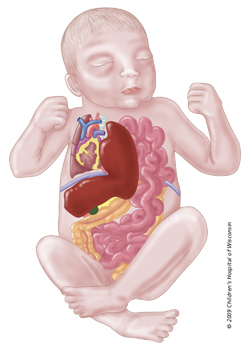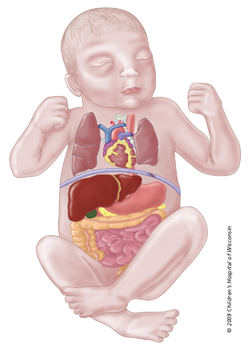After surgery your baby will need continued assistance to breathe effectively. They will need frequent lab work to monitor oxygenation, electrolytes and blood counts.
After surgery your baby may need a variety of medications including:
- Antibiotics to fight infection
- Pain medication to control pain after surgery
- Blood pressure medication to stabilize and maintain an adequate blood pressure
- Sedation to keep your baby calm
- Paralytics to keep your baby from moving
Your baby may look puffy or swollen after surgery. They will not be able to eat until their condition has stabilized. But we will provide nourishment through the IV fluids.
Because infants with this condition cannot eat for a prolonged period of time, we will supply special nourishment through a central line. Total parenteral nutrition is an IV solution that contains protein, fats, sugar, vitamins and minerals. This will supply your baby with all their nutritional requirements until they are able to take food by mouth.
Before starting feedings by mouth, we wait for signs from your baby that the bowels are beginning to work. These signs include bowel sounds, spontaneous passage of stool and a decrease in the amount of drainage coming from the tube in your baby's stomach. We typically start feedings through the tube that is in your baby's stomach. The amount we begin with is very small, and we gradually increase it as we see that your baby is tolerating the food. In those babies who need to be fed through a tube, our goal is to eventually transition to feedings by mouth if your infant is able to do so.






